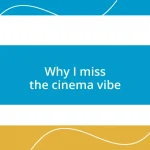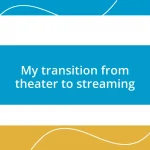Key takeaways:
- Alfred Hitchcock revolutionized the thriller genre by blending suspense with psychological depth, influencing modern filmmakers through his innovative techniques.
- His directorial methods, such as tension through editing, the use of misleading cues, and the MacGuffin concept, create enduring emotional and narrative impacts on viewers.
- Iconic scenes from films like *Psycho*, *Rear Window*, and *North by Northwest* exemplify Hitchcock’s ability to provoke introspection and manipulate visual and sound elements to evoke fear and suspense.

Understanding Hitchcock’s impact on cinema
Alfred Hitchcock revolutionized the thriller genre, blending suspense with psychological depth. I remember watching Psycho for the first time; the iconic shower scene left me breathless, redefining how terror could be portrayed on screen. Can you imagine how audiences in 1960 felt, sitting on the edge of their seats, completely unprepared for such a shocking twist?
His innovative techniques, like the use of the “suspenseful moment,” have permeated modern filmmaking. I often find myself noticing shadows and angles in contemporary films that echo his style. How many directors today owe their approach to storytelling and tension to Hitchcock’s pioneering vision?
Hitchcock’s ability to weave complex characters into gripping narratives created a blueprint for filmmakers that resonates even now. I’ve grown to appreciate how his stories often forced viewers to confront their own fears and moral dilemmas. Isn’t it fascinating how a film can provoke such introspection, long after the credits roll?

Examining Hitchcock’s directorial techniques
Hitchcock’s directorial techniques are both masterful and meticulously crafted, creating an atmosphere of tension that lingers throughout his films. One of the striking methods he employed was the use of “camera angles,” creating a sense of unease and enhancing the narrative. I still recall the first time I noticed the upward angle in Vertigo; it felt like I was glimpsing from a dizzying height, mirroring the protagonist’s fear.
Here are some key techniques that define Hitchcock’s unique style:
- Tension through editing: He expertly used cuts to build suspense, often leaving audiences breathless.
- Misleading the audience: He would often create red herrings, leading viewers away from the real action.
- The MacGuffin: This plot device served as a motivator for characters and allowed Hitchcock to focus on character interaction rather than the item itself.
- Sound design: The use of silence paired with strategic sound effects heightened emotional responses, as I experienced in The Birds.
- Close-ups and framing: He often employed close-ups to capture characters’ emotions, making me feel intimately connected to their turmoil.
Each technique not only showcases his genius but also leaves an indelible mark on viewers. I find myself rethinking these elements with every Hitchcock film I watch, identifying anew how each choice contributes to the overall experience.

Discovering iconic scenes and moments
I’ve always been drawn to the iconic scenes in Hitchcock’s films that reveal so much more than just plot. Take the moment in Rear Window when Jeffries, played by James Stewart, peers through his camera lens—it’s not just voyeurism; it’s a profound commentary on human curiosity and moral ambiguity. I remember watching that scene and feeling a mixture of excitement and discomfort as I wrestled with the voyeuristic urge to learn more about the lives unfolding around him. Isn’t it interesting how such a simple concept can leave us reflecting on our own choices?
Another scene that sticks with me is the climax of North by Northwest, where Cary Grant finds himself on a Mount Rushmore ledge, a symbol of danger that screams Hitchcock. I recall the tension that swallowed the room as I watched Grant’s character desperately evade danger. The stunning visuals and relentless pace created an almost palpable sense of panic. How does he manage to turn a national monument into a site of suspense? It’s magic, and it’s a testament to his ability to intertwine location and narrative in a way that heightens emotional stakes.
I can’t overlook the terrifying brilliance of the Psycho shower scene. The chilling score, paired with rapid cuts, captures the raw emotion of sheer horror. It was a pivotal moment for me when I realized that sound plays as crucial a role as visuals in crafting fear. I often reflect on how seamlessly Hitchcock blended audio and imagery, leaving a resonating impact that lingers long after the credits roll. How many filmmakers strive to evoke such visceral reactions today?
| Film | Iconic Scene |
|---|---|
| Psycho | The Shower Scene |
| Rear Window | Jeffries Watching Through the Lens |
| North by Northwest | The Mount Rushmore Climax |

Recommendations for further exploration
To dive deeper into Hitchcock’s world, I highly recommend exploring his lesser-known works, like Rebecca and The Trouble with Harry. These films may not carry the same blockbuster status, but they are rich with psychological depth and showcase his ingenious storytelling. I remember feeling completely absorbed in Rebecca, captivated by the haunting atmosphere and the intricacies of the characters’ relationships. Have you ever watched a film that left you pondering long after it ended? That’s the magic of Hitchcock.
Another fascinating avenue is to study the influence of Hitchcock on contemporary filmmakers. Directors like Martin Scorsese and Quentin Tarantino have openly cited him as a key inspiration. I find it intriguing to dissect how elements from films like Psycho or Vertigo echo in modern cinema. Take a moment to watch a recent thriller; can you spot the signature Hitchcockian techniques at play? This connection bridges generations of filmmaking and allows us to appreciate the timelessness of his craft.
Lastly, immersing yourself in film analysis books or documentaries about Hitchcock can provide unparalleled insights into his genius. There’s something refreshing about revisiting his films after reading critiques and analyses; it’s almost like uncovering hidden treasures. I distinctly remember watching a documentary that dissected The Birds, revealing layers of subtext I hadn’t noticed before. Have you ever had that enlightening moment where a newfound perspective reshaped your entire viewing experience? Embrace that journey of discovery—Hitchcock’s masterpieces are just as rich today as they were when they first premiered.














